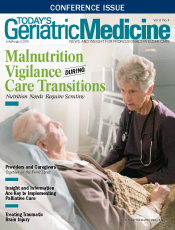
July/August 2015
Demographic Realities in US Health Care Will our system be able to provide the health care the next 20 years will require? We can be sure of few things in life, but one certainty is that we all age. The many changes in our health care system over the past 50 years have demonstrated that we can be sure of few things there as well. But the inevitable growth of our older adult population and the significant demands this will place on the health care system are among the certainties. How will we manage this expansion in a system that has been redesigned so that corporate earnings growth, rather than a focus on patient care, is the measure of success? In the past, physicians managed the health care system, and financial strain on the system was considered secondary to patient well-being. This focus resulted in a slow but steady increase in health care costs from about 1970 to the 1990s. The increase was engendered largely by technology that brought about increasingly efficient and accurate diagnosis and treatment. This benefited patients but increased costs substantially. This cost increase brought about measures to curtail it. Among these were the development of relative value units for the calculation of specific charges for specific therapeutic activities and diagnosis-related groups that provided a fixed payment for specific diagnoses and treatments. When all of these failed to halt the inexorable cost increases, corporate business was invited to insert "good business practices" into health care. That was when medicine lost its soul and patients lost their place as the focus of medical care. Corporate earnings became more important. None of the changes introduced by big business made any difference. The cost of health care as a percentage of the gross domestic product continued to climb. Business grew its middle management and executive ranks and the associated costs were added to the continuing costs of technology. The health care bill escalated as for-profit health care eroded the physician-patient relationship and made health care more of a technical exercise. This is where we are today. The aging population will become the cause of considerable strain on the health care system as their demands and needs conflict with corporate profit expectations. Older adults have many medical issues, some caused by the insecurity and worry that accompany aging and others due to chronic diseases that grow more serious. Diabetes, cardiovascular disease, and chronic lung disease are three common medical problems that plague older adults and require increasing amounts of care over time. Acute problems associated with these conditions or trauma from falls will add to the medical load. Older adults will stress the health care system over the next 10 to 20 years or until the demographic bulge of the baby boomers works its way through life. How will this be managed? The cost to the patient for health care will increase, as insurance companies and health care institutions try to maintain their profit margins. But that will not address the problem of caseload. Caseload will be managed at first by shifting the screening visits, known as primary care, from physicians to physician assistants and nurse practitioners. Physicians will serve as backup. Many problems will be managed well; many others, related to chronic disease complications, will not. There will be an inevitable decline in the quality of care for patients who need it most. Managing this burden will require more physician extenders, such as those mentioned above, which also will require more primary care physicians devoted to geriatric screening. It takes time to educate and train these individuals; this training should begin now. There is a movement to decrease the time in medical school and postgraduate training for individuals who will devote themselves to primary care. This will create two classes of physicians, which is far from ideal because it dilutes the quality of the degree. But it may be necessary. We will need more of these professionals than our present medical education system produces. We also will need enhanced and improved facilities and infrastructure specifically for geriatric patients. Simply sending the case overload to the emergency department will not solve the problem. Organizations that support older adults must advocate for these changes now so that our health care system will be prepared for the change that is coming. People who have paid the most into the health care system should receive the best care and not be set aside because our system has not prepared itself. — J. Joseph Marr, MD, of Broomfield, Colorado, is the author of Fall from Grace, a recently published retrospective on the past 50 years of medicine and the impact of social change. |
